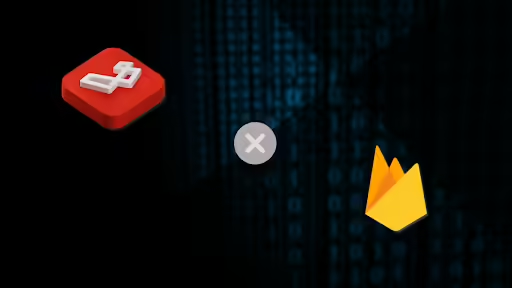Our team specializes in integrating GeoPoint in Laravel Firebase, enabling advanced location-based features such as proximity searches, tracking, and filtering. Leveraging Firebase Firestore’s GeoPoint capabilities, we efficiently manage geospatial data to meet diverse client needs. From setting up Firebase integration to configuring GeoPoint to store and query location data, we ensure seamless implementation tailored to your project requirements. With a focus on performance and scalability, we are committed to delivering high-quality solutions that drive client satisfaction.
This documentation covers our experience working with GeoPoint in a Laravel Firebase project. As part of our journey with Laravel and Firebase, we explored how to integrate geolocation functionality to store and retrieve location-based data. We will walk you through the steps, challenges, and solutions we implemented.
1. What We Learned About Integrating GeoPoint in Laravel Firebase
During our time with this project, we truly experienced the importance and practical applications of GeoPoint. It helps efficiently work with geospatial data. As we progressed, we realized how critical it is to have a reliable way of storing, managing, and processing location-based information. It’s important when dealing with real-world coordinates. Firebase’s ability to store latitude and longitude values using the GeoPoint data type proved invaluable to our project. This feature enabled us to store location points accurately. Thus, it allowed us to create, update, and query these locations with ease. Through GeoPoint, we experienced how seamless it is to work with geolocation data within Firebase. It allows us to build location-aware functionalities into our application, such as proximity searches and location-based updates. The ability to integrate geospatial data with our Laravel backend enhanced our understanding of handling complex queries and real-world datasets. This journey made us appreciate the power of cloud-hosted solutions, like Firebase, in providing scalability and performance for location-based applications.
1.1 Why We Chose GeoPoint For Our Laravel Project
We need to store precise and accurate location data for our application. This will support location-based features like tracking, searching, and filtering locations. Firebase Firestore’s GeoPoint feature offered a simple yet reliable way to manage both latitude and longitude. It manages both fields in a single field, reducing the complexity of handling separate coordinates. Additionally, GeoPoint provided a scalable solution that ensured our geolocation data remained consistent. Hence, it became easy to query, even as our dataset grew. Using GeoPoint, we could streamline data management, avoid redundancy, and implement proximity-based queries effectively. The flexibility it provided for creating, updating, and querying location data made it the ideal choice for our application’s needs.
2. Installing Firebase SDK
We began by including the necessary Firebase SDK in our Laravel project using Composer.
composer require kreait/firebase-php
During this step, we experienced a few challenges. One issue faced was dependency conflicts between the Firebase SDK and other Laravel packages. At first, the installation threw errors related to incompatible versions, which required us to adjust the package versions in the composer.json file manually. Another challenge involved network interruptions, which caused the installation process to fail midway. We overcame this by clearing Composer’s cache and running the installation command again.
Our experience with these challenges taught us the importance of reading the documentation and ensuring our Laravel project was up to date with the required dependencies. After successfully installing the SDK, verified the installation by testing a simple Firebase connection, which gave us the confidence that everything was properly set up. Although the installation wasn’t smooth initially, resolving these issues enhanced our problem-solving skills and helped us better understand how Composer manages dependencies in PHP projects.
2.1 Setting Up Firebase Configuration
To connect Laravel with Firebase, we added Firebase credentials by creating a firebase.php file in the config folder and used our Firebase project’s private key:
return [
‘credentials’ => storage_path(‘app/firebase/serviceAccount.json’),
];
During this step, we experienced a few challenges, especially when handling the Firebase service account file. One issue faced was misplacing the JSON credentials file. It caused Laravel to throw errors when trying to establish a connection. We learned that storing the credentials securely in the correct location is critical to avoid configuration issues.
Another challenge was ensuring the correct permissions for the service account. Initially, we encountered access errors when trying to read or write data to Firebase. This taught us the importance of assigning the appropriate roles and permissions to the service account in the Firebase Console. Additionally, we had to update the .gitignore file to ensure the private key wasn’t accidentally committed to version control, which reinforced the importance of security best practices.
Our experience with setting up the configuration helped us better understand how to integrate external services into Laravel projects. Despite these initial challenges, we were able to establish a reliable connection between Laravel and Firebase. It laid the foundation for seamless communication between our backend and Firebase Firestore. This process enhanced our ability to troubleshoot configuration issues and work with cloud-based services securely and efficiently.
3. Creating and Storing GeoPoint
Based on our experience, storing a GeoPoint in Firebase is quite straightforward. We found that using the GeoPoint data type made it easy to manage both latitude and longitude coordinates. Both the coordinates can be managed within a single field. During the process, we created several location records to store geospatial data effectively. Here’s how we approached it:
use Google\Cloud\Firestore\FirestoreClient;
function storeLocation($latitude, $longitude) {
$firestore = new FirestoreClient();
$collection = $firestore->collection('locations');
$collection->add([
'name' => 'My Location',
'coordinates' => $firestore->geoPoint($latitude, $longitude),
]);
}When we implemented this code, we realized how convenient it was to use Firebase’s GeoPoint feature compared to managing coordinates separately. We did face a few minor challenges, such as ensuring that the latitude and longitude values were within valid ranges (latitude between -90 to 90 and longitude between -180 to 180). It also helped us to learn that any typo in the field names or structure could cause silent errors. Thus, it is essential to double-check the data format.
This process gave us valuable experience in building location-based functionalities for our application. We felt confident working with GeoPoint, knowing that we could easily store, retrieve, and update geospatial data as needed. This also opened up opportunities for us to explore more advanced geolocation queries. It included filtering results based on proximity, which we found both exciting and rewarding.
4. Retrieving and Querying Locations
During our journey with this project, we explored and experienced the process of retrieving and querying locations. It was based on their proximity to a specific point. This part of the project was both exciting and challenging, as we had to figure out how to efficiently filter location data using GeoPoint. Initially, we thought it would be straightforward, but quickly we learned that working with geospatial queries in Firebase requires a careful approach.
We found that Firebase Firestore doesn’t support direct distance-based queries, which meant we had to think creatively and experiment with bounding box queries. This approach allowed us to query locations by creating latitude and longitude ranges around the target point. Here’s how we implemented the solution:
function getNearbyLocations($latitude, $longitude, $radius) {
$firestore = new FirestoreClient();
$collection = $firestore->collection('locations');
$locations = $collection
->where('coordinates', '>=', $firestore->geoPoint($latitude - $radius, $longitude - $radius))
->where('coordinates', '<=', $firestore->geoPoint($latitude + $radius, $longitude + $radius))
->documents();
foreach ($locations as $location) {
echo $location['name'] . "\n";
}
}In our experience, one of the biggest challenges was finding an efficient way to query large datasets without exceeding Firestore’s query limits. We realized that bounding box queries provide a quick way to narrow down the search area. However, they are not always 100% accurate for circular proximity searches. As a result, we had to experiment with different radius values and test multiple scenarios to fine-tune the query logic.
Through this process, we gained hands-on experience in managing geospatial data. It also helped us to learn the importance of query optimization to maintain performance. It also helped us to discover that Firebase’s query constraints, such as the limit on range-based filters, required careful query design. We also needed to handle edge cases, like locations near the edge of the bounding box.
Despite these challenges, we found the experience rewarding. It gave us a deeper understanding of how to use GeoPoint effectively. It also helps us to know how to implement proximity-based location features in our application. This experience also encouraged us to explore more advanced geospatial tools, such as integrating external APIs for more precise distance calculations. Overall, working with GeoPoint queries has been a valuable learning experience that significantly improved our skills in building location-aware applications.
5. Challenges We Faced and Solutions Found
While working with GeoPoint, we encountered several challenges that required careful problem-solving and experimentation. Below are some of the key challenges faced and how we tackled them based on our experience.
5.1 Challenge: GeoPoint Query Limitations
One of the biggest challenges we experienced was that Firebase Firestore does not directly support proximity searches using distances (like finding locations within a certain radius). Initially, this limitation felt frustrating, as we expected to perform distance-based queries seamlessly.
Our Solution:
To overcome this, we explored different approaches and eventually found that using bounding box queries with latitude and longitude ranges was the most effective solution. Although this method doesn’t guarantee perfect circular proximity, it allowed us to narrow down results efficiently. We had to experiment with various radius values to strike a balance between accuracy and query performance.
This experience gave us valuable insights into how GeoPoint data can be queried effectively, even with limitations. It also helped us to optimize our application’s design by combining bounding box logic with client-side filtering for finer results.
5.2 Challenge: Managing Multiple GeoPoints
Another challenge faced was managing multiple GeoPoints for different users and locations. We needed to ensure that each user could store and access their locations without running into data conflicts or overlapping records.
Our Experience:
Initially, we struggled with data management because having all location data in a single collection quickly became unmanageable and prone to errors. After some trial and error, we realized that creating separate collections or subcollections for each user made the data structure more organized and easy to work with. Here’s how we implemented it:
$firestore = new FirestoreClient();
$userCollection = $firestore->collection('users')->document($userId)->collection('locations');
$userCollection->add([
'name' => 'User Location 1',
'coordinates' => $firestore->geoPoint($latitude, $longitude),
]);This experience taught us the importance of structuring databases logically to avoid conflicts. By using separate collections for each user, we ensured data isolation and made it easier to query and update location records without affecting other users. We also improved performance by limiting the size of individual collections, which made it faster to retrieve relevant data.
Through these challenges, we learned to design scalable database structures and optimize data management practices for real-world applications. Although working with GeoPoint introduced some complexities, overcoming these hurdles strengthened our understanding of how to efficiently handle geospatial data in Firebase Firestore.
6. Conclusion and Our Learning
In conclusion, our experience working with GeoPoint in this Laravel Firebase project was incredibly educational and rewarding. We gained practical knowledge about how to store, retrieve, and query geolocation data effectively, which deepened our understanding of handling geospatial data within a real-world application.
Throughout the project, we encountered challenges—such as GeoPoint query limitations and managing multiple locations for different users—but each challenge provided valuable learning opportunities. We overcame these obstacles by exploring alternative solutions, such as using bounding box queries to approximate proximity searches and structuring collections logically to prevent data conflicts. These experiences improved our problem-solving abilities and gave us confidence in working with Firebase’s cloud infrastructure and geolocation tools.
Additionally, integrating Firebase with Laravel was an eye-opening experience. We learned how to configure Firebase credentials properly, manage dependencies using Composer, and set up reliable communication between Laravel and Firebase Firestore. This project also enhanced our skills in query optimization, data organization, and secure key management.
Moving forward, our next step will be to explore more advanced queries, such as real-time location updates and complex proximity searches. We also plan to experiment with external geolocation libraries or APIs to implement more accurate distance-based queries.
This project gave us hands-on experience that we will carry forward into future endeavors involving cloud databases, geospatial data, and scalable backend solutions. Now we feel well-prepared to take on new challenges and push the boundaries of what can be built with Laravel, Firebase, and GeoPoint-based applications.
7. Future Improvements and Ideas
As we reflect on our experience, we realize there are several ways to enhance and expand the functionality of our project. While working with GeoPoint and Firebase has been a valuable learning experience, we identified areas for improvement and new ideas to explore in the future.
7.1 Implementing Radius-Based Search
One of the improvements we plan to implement is integrating a radius-based search using the Haversine formula. Although bounding box queries helped us to get started with proximity-based searches, they lacked the precision needed for accurate distance calculations over larger areas. Applying the Haversine formula, which calculates the great-circle distance between two points on the Earth’s surface, we can significantly improve the accuracy of our proximity searches.
This enhancement allowed us to filter location results more precisely within a given radius and create better user experiences for applications that rely heavily on location-based services (e.g., finding nearby restaurants, stores, or events). We plan to experiment with this formula within our Laravel application and combine it with Firebase queries for an optimized solution.
7.2 Real-Time Updates and Location Tracking
Another area we want to explore is implementing real-time location tracking using Firebase’s real-time database. This feature would allow our application to monitor location changes continuously and provide up-to-the-minute updates for users. We see a lot of potential in adding real-time tracking for use cases like delivery tracking, ride-sharing services, or emergency response systems.
While Firestore provides excellent query capabilities, we realized that Firebase’s real-time database offers faster synchronization and real-time data updates. This makes it more suitable for tracking dynamic location changes. Thus, we plan to integrate both Firestore and the real-time database strategically to balance the need for structured data with the demands of real-time location updates. We may also experiment with triggers or webhooks to update Firestore records whenever a user’s location changes, ensuring both databases remain in sync.
7.3 Additional Ideas
- User Alerts Based on Location: We want to explore geo-fencing to send alerts or notifications to users when they enter or leave a specific area.
- External Geolocation APIs: We are considering integrating external APIs, such as Google Maps or OpenStreetMap, to enhance location features and provide more accurate maps and directions.
- Batch Location Updates: For better efficiency, we aim to optimize batch updates for handling large datasets and improving performance during high-traffic scenarios.
- Offline Location Storage: We also want to investigate ways to store location data locally on devices when there is no internet connectivity and sync it with Firebase once a connection is restored.
By working on these improvements and new ideas, we hope to take our project to the next level. These enhancements will not only improve performance and accuracy but also allow us to build more complex and feature-rich applications. Our experience so far has inspired us to keep learning and exploring new tools and techniques for managing geospatial data.
8. Our Personal Experience Takeaway
Working with Laravel and Firebase has been a profoundly rewarding experience that has significantly shaped our understanding of geolocation technologies. Throughout this project, we found GeoPoint integration to be not only simple but also exceptionally powerful for handling geolocation needs. This ease of use allowed us to focus more on developing features that directly enhance user experience rather than getting bogged down in complex data management issues.
Through this project, we realized the immense potential of combining cloud technologies with PHP frameworks like Laravel to build feature-rich applications that can scale efficiently. The flexibility and scalability of Firebase, paired with Laravel’s robust backend capabilities, created a seamless environment for developing dynamic and interactive applications.
Additionally, this journey has been an excellent opportunity for personal and professional growth. We faced various challenges that required us to think critically and adapt quickly. Each obstacle taught us valuable lessons about problem-solving, resourcefulness, and the importance of community support when navigating technical issues. Engaging with documentation, forums, and tutorials further enhanced our understanding and proficiency.
As we progressed, we became increasingly aware of how vital accurate geolocation data is in today’s applications. It opens doors to innovative features such as personalized user experiences, location-based services, and efficient resource management. We feel empowered by our ability to harness these technologies effectively and look forward to exploring even more advanced geospatial functionalities in the future.
This experience has not only enhanced our technical skills but also enriched our confidence in tackling complex projects. We are excited about the potential for future projects involving Firebase and Laravel, as we now have a solid foundation in handling geospatial data and the ability to leverage cloud solutions in a meaningful way.








